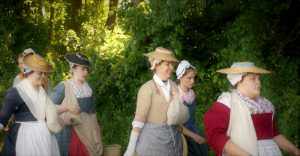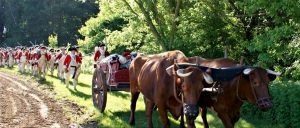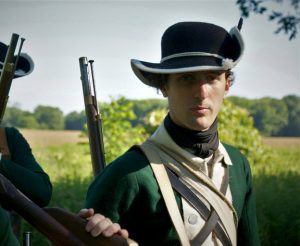In addition to museums and historical sites, a way to learn about Revolutionary War history is to attend a reenactment. There are many, large and small, all over the country. Each year commanders of reenactment organizations throughout the country select two events that they will all support, insuring an especially large turnout of participants, and, therefore, an especially impressive visual spectacle for the audience. The first such event for 2018 was held on June 16-17 at Monmouth Battlefield in Freehold, New Jersey. As one of the more significant battles of the Revolutionary War, battle reenactments are held there annually, but this year marked the 240th anniversary of the actual battle.

The central component of most reenactments is the battle reenactment itself, usually scheduled in the early afternoon. But there is a lot more to see, and opportunities to interact with the participants which offer the greatest opportunity for learning. Many of the participants camp at the site, sleeping in canvas tents and cooking with tin-plated iron kettles that are similar to those used in the eighteenth century. At an event the size of Monmouth, there are hundreds of tents arranged according to original military manuals, teeming with soldiers and civilians anxious to talk to interested spectators about all aspects of their clothing, equipment, procedures and experiences.
This year’s Monmouth event featured an extraordinary scenario organized by participants who wanted a more extensive experience than just the encampment. Early on Saturday morning they gathered two miles away from the site, and marched to the encampment. Not marched like a parade, but marched like an army on campaign, laden with knapsacks and equipment. A two-ox team pulled a baggage wagon, a very rare sight at reenactments. The route avoided modern intrusions to the greatest extent possible, but still had to cross some roads to the delight and awe of motorists. One of the participants, a long-time reenactor, called it “the closest I’ve felt to being part of an actual body of troops moving as they would have during the time.” Anyone who arrived early enough to see these weary campaigners trudge into camp witnessed a rare event indeed.

For me, though, the heart of battle reenactments are the battles, and Monmouth produced an outstanding one each day. For those who have never been to Monmouth Battlefield you should know that it is a state park. The Visitors Center sits on a hill upon which, in June of 1778, American cannon rained canister and grape shot down upon the British. There is a marshy creek at the foot of the hill lined with trees (which unfortunately obscures a lot of the fields beyond the creek) and once you cross a footbridge over the creek, before you stretches a cornfield with a cherry orchard about 500 yards past that on a ridge and an apple orchard off to the right. Much of this land witnessed fighting in late June 1778, and so participants recreate some of that fighting on the actual ground!

I attended with the unit that I belong to, the 7th Virginia Regiment, and had the honor to command the rifle company (made up of people from several units) amounting to about twenty-five riflemen. The battle scenario planners did a fantastic job drawing up two scenarios that made good use of the vast space, much larger than most reenactments. The American column marched from camp, crossed the creek and deployed at the edge of the cornfield. 500 yards away on the ridge with the cherry trees were several British cannon and a couple of mounted dragoons. The British guns opened up and then nine American guns replied. From my position among the American troops, I was thrilled to see that artillery barrage play out at realistic distances, but what really blew me away was when the British army emerged from behind/among the apple orchard, marched past their cannon, and deployed for battle. They did so at a trot and it looked the way I have always imagined it would in real life. There was an urgency or rush to their movements and I stood there grinning from ear to ear thinking how cool it looked. I only hope that spectators could see this unfold as clearly as I could, and appreciated the spectacle.
Getting back to the battle, the Crown forces (because there were Germans there too) deployed rapidly and then started advancing as one long battle line. Again, the optics were fantastic. Picture a field of thigh high corn stretching out over 400 yards and at the other end are close to 400 Redcoats and their German allies marching towards you. And you have a weapon that fires one shot at a time (every thirty seconds if you are me with a rifle, half that if you have a musket).

Now I must say that the fighting in the cornfield was fun and intense, but I’m not sure how much could be seen by the crowd. To address this, we withdrew to the other side of the creek and fought the other half of the battle in full view of the crowd. The intensity was maintained, but with limited space we couldn’t really do much moving and the firing distances were no longer as realistic. The crowd seemed pleased, though, and that is important.

On Sunday the scenario was reversed, with the Americans starting in the orchard. A battle scenarios doesn’t try to exactly recreate a battle, but instead demonstrates something of what the tactics, sights, sounds and smells were like. Safety is always the first priority and in being safe you have to avoid some of the aggression that actually occurred in battle. That said, the scenarios at Monmouth made an effort is made to stage portions of what actually occurred. And this is true of other aspects of the reenactment – the encampment, the march, and many of the details of what the participants wear, use and do. There may be inaccuracies, but the important thing is to look at how much is accurate, and learn what can be learned in spite of the concessions that must be made to modern limitations.
I’m happy to report that on both days at Monmouth, I time travelled back to 1778. The organizers, as well as all of the combatants who “raised their game” in these battles, did a great job and I leave Monmouth very proud to be a Revolutionary War reenactor.








8 Comments
Mr. Cecere, thank you for this highly descriptive article. While I have thought about pursuing Revolutionary War reenacting for quite some time, though articles like this add a sense of urgency, since I don’t wish to miss out on future events like this one. I actually met you while at LHS, having graduated in 2001, though I was in a different class. I remember you did an event for the US History students where you wore your reenactor gear. It was one of the more memorable moments of my time at LHS.
Where is the battlefield in relation to Ft. Monmouth, New Jersey? I was stationed there in 1954 and lived on Atlantic Avenue in Long Branch, New Jersey.
Monmouth Battlefield State Park is in Manalapan, New Jersey, bordered by Business Route 33, Wemrock Road, and Route 522. The entrance to the park is about two miles west of Route 9, but elements of both armies actually crossed Route 9, roughly from where Jersey Freeze is, north to Schibanoff Lane in Freehold.
I had the good fortune of being at that particular reenactment this year. Was super very impressed by it all. Originally I’m from Brooklyn, New York and moved to New Jersey in 2011 I got really into the local history of this state seeing all these historical houses and events particularly from the early colonial period.
We are fortunate that the state government has preserved so much of the area as Monmouth Battlefield State Park. It is in a well developed county, yet the historic portion is safe. There is also what I consider to be the highlight of the area, the Old Tennant Church, which saw the battle and has an appealing cemetery surrounding it. Monmouth is well worth a visit, especially if linked with a trip to Washington Crossing State Park on the New Jersey side of the Delaware River. Now that I think about it, why aren’t Washington Crossing and Monmouth both part of the Morrristown National Historic Park? “American Revolution National Park. That might be a worthy project for Revolutionary War buffs.
Great article, and outstanding photography. ‘Charge through an orchard’ and ‘The baggage train’ are so well composed that I thought at first glance that they must be paintings. Well done Michael, Jason and Brandon.
I was a participant in the march (wheeled a barrow a good portion of the way) and laundered in the Advance Camp for the remainder of the weekend. It was an amazing experience, and one of several in New Jersey that I’ve been incredibly fortunate to immerse myself in. Brandyn’s and Jason’s photos are a lens into the entire weekend, and I encourage folks to peruse them further! There are more amazing things coming down the pike from the followers of the Civilian Contingent, and the members of the Advance Corps!
Thank you Stephen, but full disclosure obligates me to acknowledge Don Hagist’s editorial work on the article. In fact, he took my draft and the photos and added his own context about reenacting to create the article, but generously gave me and the others credit. Don and the other editors at JAR are the Nathanael Greene’s of the journal, essential to the cause and yet inadequately recognized or appreciated for what they do.
And Tim, if you are still interested in this stuff (which you obviously are) we need to get you into the field with your fellow Virginians. The next national event is at Mount Harmon in Maryland on Sept. 15-16.